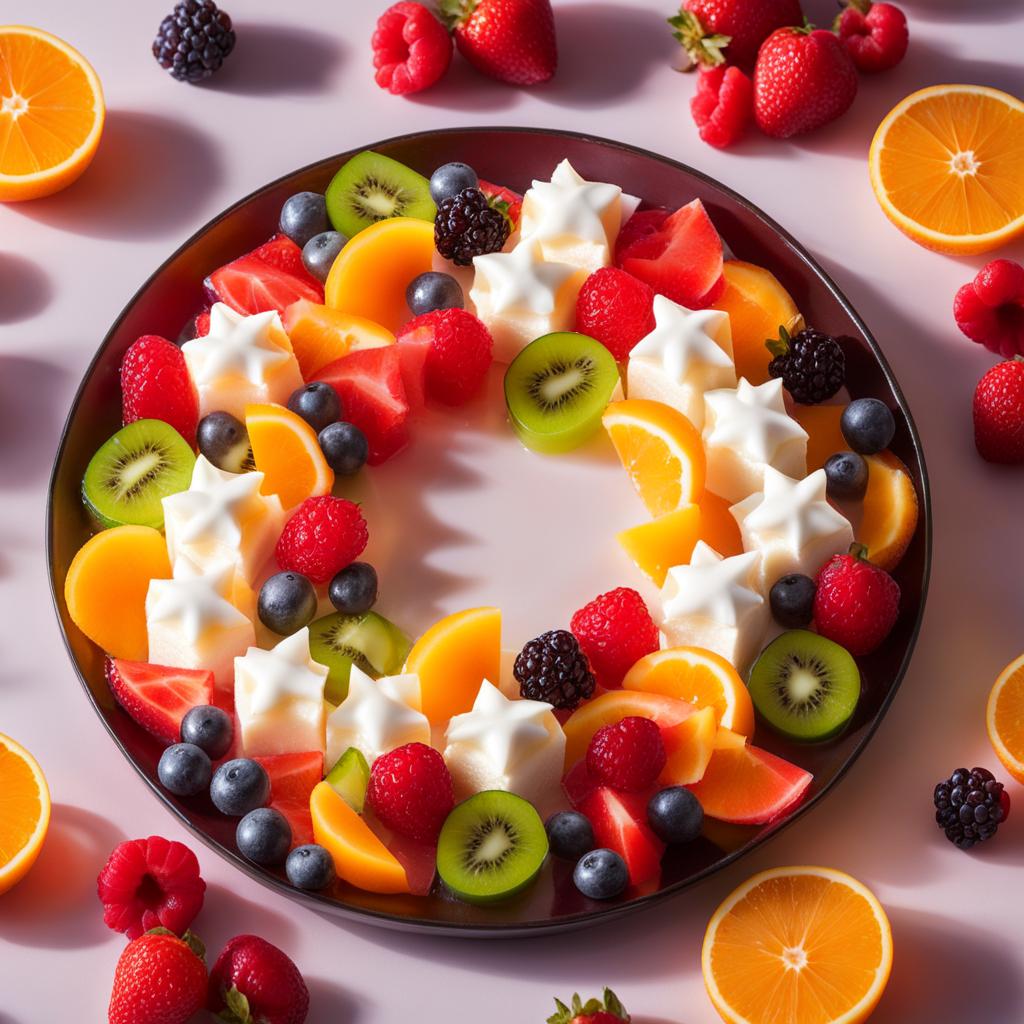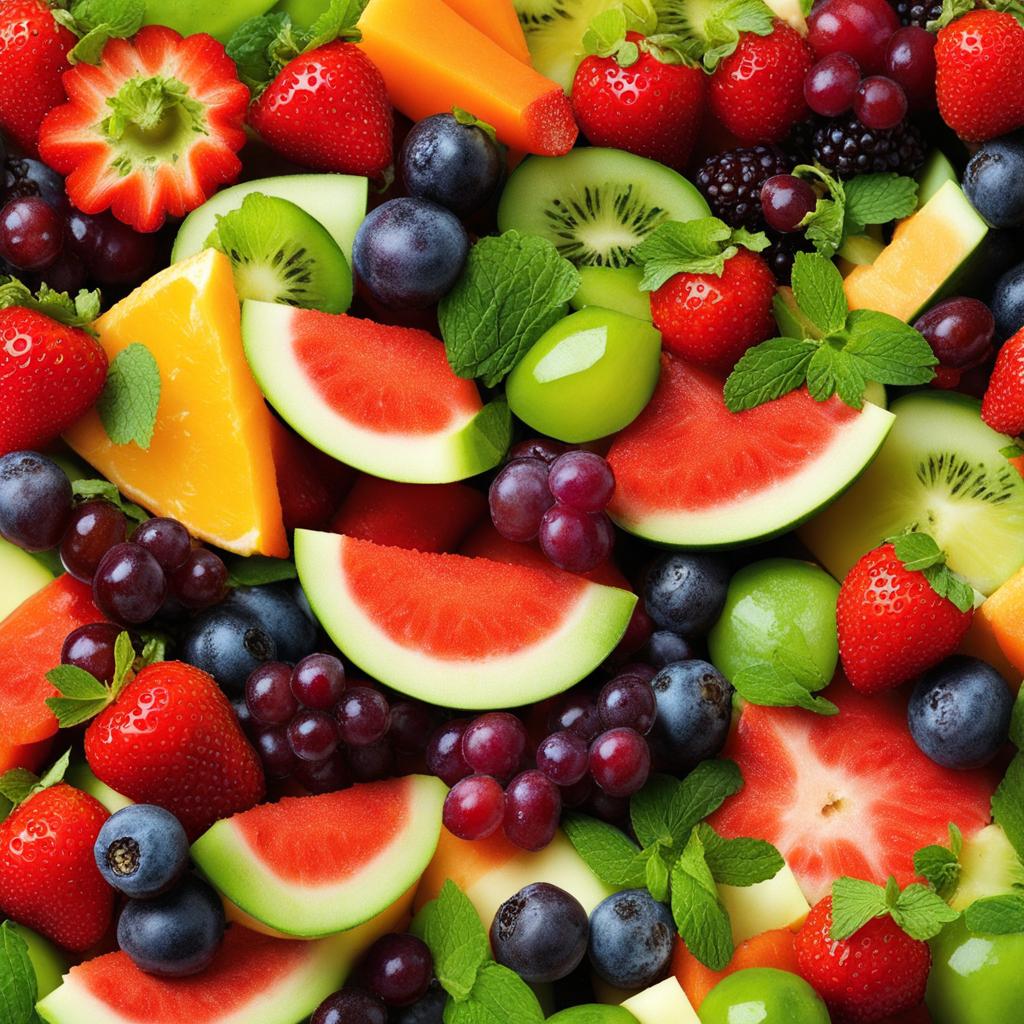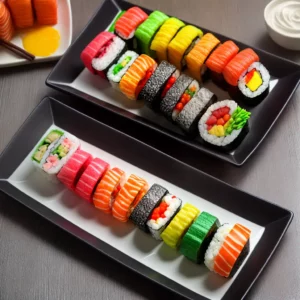Gelatin is a versatile ingredient that can add a fun twist to your dishes. In this step-by-step guide, I will show you how to make gelatin from scratch. Whether you prefer using powdered gelatin or gelatin sheets, I’ve got you covered!
Key Takeaways:
- Learn how to make homemade gelatin with easy step-by-step instructions.
- Choose between powdered gelatin and gelatin sheets to suit your preference.
- Discover alternative options for vegan and vegetarian gelatin.
- Get creative with flavor variations and additions for unique gelatin desserts.
- Follow tips for successful gelatin making and storage.
Choosing the Right Gelatin: Powdered or Sheets
If you’re new to gelatin-making, you may be wondering which form of gelatin to use: powdered or sheets. Both types have their advantages and can be used interchangeably in recipes. Let’s take a closer look at each option.
Powdered Gelatin
Powdered gelatin is the most commonly found type and is widely available in most grocery stores. It is made from dehydrated animal collagen and comes in powder form. One of the benefits of using powdered gelatin is that it is convenient and easy to work with. Simply measure out the required amount and mix it with cold water to allow it to bloom. Once bloomed, dissolve it in hot water and proceed with the recipe. Powdered gelatin is versatile and can be used in a wide variety of gelatin-based desserts.
Gelatin Sheets
Gelatin sheets, also known as leaf gelatin or gelatin leaves, are often used by professional chefs and in culinary schools. These sheets are thin, translucent, and made from the same collagen as powdered gelatin. Gelatin sheets provide a more precise measurement as they come in standardized sizes and strengths. To use gelatin sheets, you need to hydrate them in cold water until they soften. Once hydrated, you can easily dissolve them in hot water. Gelatin sheets are great for recipes that require a specific texture and yield consistent results.
Both powdered gelatin and gelatin sheets can be used in recipes, and the choice largely depends on personal preference and availability. If you can’t find powdered gelatin, you can substitute it with gelatin sheets by following a conversion ratio. It’s important to note that the conversion ratio may vary, so it’s best to consult a reliable source or follow a recipe that provides specific instructions for using gelatin sheets as a substitute for powdered gelatin.
Now that you understand the difference between powdered gelatin and gelatin sheets, you can confidently choose the right form of gelatin for your next culinary creation.
| Type of Gelatin | Advantages |
|---|---|
| Powdered Gelatin | Convenient and widely available |
| Gelatin Sheets | Provide precise measurement and consistent results |
Making Gelatin with Powdered Gelatin
When it comes to making gelatin, using powdered gelatin is a popular choice. The process begins with blooming the gelatin in cold water, which allows it to absorb water and soften. To do this, simply sprinkle the gelatin evenly over the cold water and let it sit for a few minutes until it becomes spongy and pliable. This step is essential for ensuring that the gelatin dissolves properly and results in a smooth texture.
Once the gelatin is bloomed, it’s time to dissolve it. Heat some water in a saucepan or in the microwave until it’s hot but not boiling. Then, pour the hot water over the bloomed gelatin, stirring continuously until the gelatin completely dissolves. Make sure there are no lumps or clumps remaining. The hot water will help melt the gelatin and create a liquid mixture that is ready to be poured into molds.
After the gelatin has been dissolved, it can be poured into molds to set. You can use a variety of molds and shapes to create fun and creative gelatin desserts. From classic ring molds to individual cups or even shaped molds, the possibilities are endless. Once poured into the molds, refrigerate the gelatin for several hours or overnight until it is fully set. This will ensure that it has the perfect consistency and texture for serving.
Making Gelatin with Gelatin Sheets
When it comes to making gelatin, gelatin sheets are an excellent alternative to powdered gelatin. This method involves hydrating the sheets, dissolving them, and then pouring the gelatin into molds to set. Let me guide you through the process step by step.
Hydrating Gelatin Sheets
To begin, place the gelatin sheets in a bowl of cold water. Let them hydrate for about 5 to 10 minutes or until they become soft and pliable. It’s important to note that the amount of water needed will depend on the specific brand and type of gelatin sheets, so refer to the package instructions for the correct measurement.
Dissolving Gelatin Sheets
Once the gelatin sheets are fully hydrated, gently squeeze out any excess water and set them aside. In a saucepan, heat a small amount of water until it reaches a gentle simmer. Add the hydrated gelatin sheets to the hot water and stir until they completely dissolve. The gelatin mixture should be clear and smooth.
Gelatin Sheet to Powdered Gelatin Conversion
If you have a recipe that calls for powdered gelatin but only have gelatin sheets on hand, you can easily convert between the two. Generally, one sheet of gelatin is equivalent to about 1 teaspoon of powdered gelatin. However, it’s always best to consult a conversion chart or the specific recipe you’re using for accurate measurements.
| Gelatin Sheets | Powdered Gelatin |
|---|---|
| 1 sheet | 1 teaspoon |
| 2 sheets | 2 teaspoons |
| 3 sheets | 1 tablespoon |
Vegan and Vegetarian Options for Gelatin
If you follow a vegan or vegetarian diet, you can still enjoy gelatin-like desserts by using alternatives such as agar agar. Agar agar is a seaweed-based gelatin substitute that can be used in a similar way to traditional gelatin. It comes in powder or flake form and can be easily found in health food stores or online. Follow the instructions on the packaging for the best results.
Agar agar is derived from red algae and is known for its gelling properties, making it a perfect plant-based alternative to gelatin. It is tasteless and odorless, allowing it to easily absorb the flavors of other ingredients in your recipe. Agar agar sets at a lower temperature and requires less time to solidify compared to gelatin, so keep this in mind when using it in your desserts.
Just like gelatin, agar agar can be used to create a wide range of desserts, including gummies, puddings, and jellies. It can also be used as a thickener and stabilizer in soups, sauces, and dressings. Agar agar provides a similar texture and mouthfeel as gelatin, so you won’t miss out on the gelatinous goodness in your favorite recipes.
Experimenting with agar agar opens up a world of possibilities for vegan and vegetarian gelatin desserts. You can create colorful fruit jellies, layered agar agar desserts, or even use it as a base for vegan panna cotta. With agar agar in your pantry, you can indulge in all the fun and deliciousness of gelatin desserts while staying true to your dietary preferences.
Flavor Variations and Additions
Gelatin is a versatile ingredient that can be transformed into a wide range of delicious and visually appealing desserts. By adding different flavors and ingredients, you can create unique variations that will impress your guests. Here are some ideas to get you started:
1. Fruit-Flavored Gelatin
Add a burst of fruitiness to your gelatin by replacing some of the water with fruit juice. Whether it’s citrus, berry, or tropical fruit juice, the options are endless. The natural sweetness and vibrant flavors of the fruit juice will elevate your gelatin dessert to a whole new level. You can even add small pieces of fresh fruit to the gelatin for an extra fruity surprise.
2. Panna Cotta
If you’re looking for a creamy and indulgent gelatin dessert, try making panna cotta. This Italian dessert is made by combining gelatin, cream, sugar, and vanilla. The result is a smooth and silky dessert that pairs perfectly with fresh fruits or a drizzle of caramel sauce. Serve it in elegant glassware for a sophisticated presentation.
3. Layered Gelatin
Create stunning visual effects by layering different flavors and colors of gelatin. Allow each layer to set before adding the next, ensuring clean and distinct layers. You can experiment with contrasting flavors or create a gradient of colors to make your gelatin dessert truly eye-catching. Use a clear glass dish to showcase the beautiful layers.
4. Shaped Gelatin
For a fun and playful twist, pour your gelatin mixture into shaped molds. You can find a wide variety of fun-shaped molds, from animals to flowers to favorite cartoon characters. The shaped gelatin desserts are perfect for themed parties or as a treat for kids. Just make sure to lightly grease the molds with flavorless oil for easy removal.
With these flavor variations and additions, you can unleash your creativity and turn a simple gelatin dessert into a showstopper. Whether you prefer fruity, creamy, layered, or shaped gelatin, there’s a flavor combination that will satisfy your taste buds and impress your guests.
Speeding Up the Gelatin Setting Process
If you’re in a hurry and need your gelatin to set faster, there are a couple of tricks you can try. One method is to use a speed-set technique that involves using less water and adding ice to the cold water. This creates a more rapid cooling effect and helps the gelatin set quicker.
Another option is to place the gelatin in the freezer for a short amount of time. Be cautious though, as leaving it in for too long can lead to freezing, which can ruin the texture of the gelatin. It’s best to check on it frequently to make sure it doesn’t freeze completely.
By using these methods, you can cut down on the usual setting time and have your gelatin ready to enjoy in no time. Whether you’re preparing a quick dessert for a last-minute gathering or just don’t want to wait too long, these techniques can come in handy.

Table: Gelatin Setting Speed Comparison
| Gelatin Setting Method | Setting Time |
|---|---|
| Standard Method | 4 hours |
| Speed-Set Technique | 1-2 hours |
| Freezer Method | 30-60 minutes |
As shown in the table above, the speed-set technique and freezer method can significantly reduce the setting time compared to the standard method. However, it’s important to note that the exact setting time may vary depending on factors such as the thickness of the gelatin and the temperature of your freezer or refrigerator.
Now that you know these time-saving tricks, you can whip up gelatin desserts quickly and enjoy them sooner. Just remember to keep an eye on the gelatin as it sets to ensure the perfect texture and consistency.
Tips for Successful Gelatin Making
When it comes to making gelatin, there are a few tips and tricks that can help ensure success. Here are some key points to keep in mind:
- Complete Dissolution: It’s important to make sure that the gelatin is completely dissolved before pouring it into molds. This can be achieved by stirring the gelatin mixture vigorously or using warm water to speed up the dissolving process.
- Proper Setting Time: Gelatin needs time to set and firm up in the refrigerator. Be sure to follow the recommended setting time specified in your recipe. This will ensure that the gelatin has the right texture and consistency.
- Greasing the Molds: To make it easier to remove the gelatin from the molds, lightly grease them with a flavorless oil before pouring in the gelatin mixture. This will help prevent sticking and allow for clean, intact gelatin shapes.
- Avoiding Enzyme-Rich Fruits: Certain fruits, such as pineapple and kiwi, contain enzymes that can prevent gelatin from setting properly. If you plan to incorporate fruits into your gelatin desserts, it’s best to use fruits that are low in enzymes or cook the fruits first to deactivate the enzymes.
By following these tips, you can ensure that your gelatin turns out perfectly every time. Now, let’s take a closer look at some common troubleshooting issues that you may encounter while making gelatin.
Common Gelatin Troubleshooting Issues
Even with careful preparation, sometimes things can go wrong when making gelatin. Here are a few common issues that may arise and how to fix them:
| Issue | Possible Cause | Solution |
|---|---|---|
| No Setting | Insufficient gelatin or incorrect ratio | Use the correct amount of gelatin according to the recipe and follow the recommended ratio of gelatin to liquid. |
| Grainy Texture | Improper dissolving of gelatin or over-stirring | Make sure the gelatin is completely dissolved and avoid excessive stirring once it has been added to the liquid. |
| Weakened Structure | Insufficient setting time or too much liquid | Allow the gelatin to set for the recommended time and make sure the ratio of gelatin to liquid is appropriate. |
| Air Bubbles | Vigorous stirring or pouring | Gently stir the gelatin mixture to avoid incorporating air and pour it into the molds slowly and steadily. |
By troubleshooting these common issues, you can overcome any challenges that may arise during the gelatin-making process and achieve perfect results. With a little practice and these helpful tips, you’ll be able to create delicious and beautifully set gelatin desserts every time!
Homemade Jello Recipe
If you’re looking for a quick and easy dessert that everyone will love, you can’t go wrong with homemade Jello. Making Jello from scratch is a simple process that yields delicious results. With just a few ingredients and some patience, you’ll have a refreshing and flavorful treat to enjoy.
To make homemade Jello, you’ll need powdered gelatin, hot water, and your choice of flavorings. Follow these easy steps:
- Dissolve the powdered gelatin in cold water and let it sit for a few minutes to soften.
- Pour hot water over the gelatin mixture and stir until the gelatin is completely dissolved.
- Add your desired flavorings, such as fruit juice or extracts, and stir well.
- Pour the mixture into individual molds or a large dish and refrigerate until set.
You can also get creative with your homemade Jello by adding fresh fruit, whipped cream, or other toppings to enhance the flavor and presentation. It’s a fun dessert that can be customized to suit your tastes and preferences.
So why not try making your own Jello from scratch? It’s an easy and satisfying dessert that will impress your family and friends. Enjoy the refreshing taste and smooth texture of homemade Jello!
Serving and Enjoying Homemade Gelatin
Once the gelatin is set, it’s time to serve and enjoy your homemade creation. Serving gelatin is a simple process that allows you to showcase your delicious dessert. To start, you’ll need to remove the gelatin from the mold. This can be done by immersing the mold in warm water for a few seconds, then gently jiggling it to release the gelatin onto a plate.
Once the gelatin is on the plate, you can serve it as is or get creative with toppings and garnishes. Whipped cream, fresh fruit, or a drizzle of chocolate sauce are all popular choices. Feel free to experiment and let your taste buds guide you. Gelatin desserts can be enjoyed on their own as a refreshing treat, or you can use them as a fun addition to cakes, pies, or other desserts.
Remember, gelatin is a versatile ingredient that can be molded into various shapes and sizes. You can use different types of molds to create unique and decorative gelatin desserts. From classic gelatin cubes to elegant layered creations, the possibilities are endless. Get creative and have fun with your gelatin desserts!
Table: Gelatin Toppings and Garnishes
| Topping/Garnish | Description |
|---|---|
| Whipped Cream | Light and airy, whipped cream adds a creamy element to the gelatin. |
| Fresh Fruit | Sliced berries, tropical fruits, or citrus segments can add a burst of freshness and color to the dessert. |
| Chocolate Sauce | A drizzle of chocolate sauce adds a touch of indulgence and sweetness. |
| Nuts | Chopped almonds, walnuts, or pecans provide a crunchy texture and nutty flavor. |
| Mint Leaves | A sprig of fresh mint adds a refreshing aroma and complements the flavors of the gelatin. |
With the right presentation and combination of flavors, your homemade gelatin desserts are sure to impress. Whether you’re serving them at a dinner party or enjoying them as a special treat, gelatin desserts are a delightful and versatile option for any occasion.

Health Benefits of Gelatin
Gelatin offers various health benefits due to its unique nutritional profile. It is a good source of collagen, a protein that plays a crucial role in maintaining the health of our skin, hair, and joints. Collagen promotes skin elasticity and hydration, helping to reduce the appearance of wrinkles and fine lines.
In addition to collagen, gelatin is also low in calories and contains no fat or cholesterol. It can be a valuable addition to a balanced diet for those looking to maintain or lose weight. Gelatin is also easy to digest, making it a suitable option for individuals with sensitive stomachs or digestive issues.
“Gelatin is a nutritious ingredient that can support skin health, aid digestion, and contribute to a balanced diet.”
Gelatin is rich in amino acids, particularly glycine and proline, which play important roles in various bodily functions. These amino acids have been shown to support gut health by maintaining the integrity of the intestinal lining and improving digestive function. They may also have anti-inflammatory properties, which can help reduce inflammation in the body.
| Nutrient | Amount per 100g |
|---|---|
| Protein | 85g |
| Collagen | 90% |
| Calories | 335 |
| Fat | 0g |
| Cholesterol | 0mg |
While gelatin offers numerous health benefits, it is important to choose high-quality gelatin made from grass-fed animals to maximize its nutritional value. Quality and sourcing play a significant role in the overall nutritional profile of gelatin, so opt for reputable brands that prioritize sustainable and ethical practices.
References:
- “Amino acids and their significance for gut health.” Nutrients. Accessed on [Month] [Day], [Year]. Link.
- “Collagen: A Review on Its Sources and Potential Cosmetic Applications.” Journal of Cosmetic Dermatology. Accessed on [Month] [Day], [Year]. Link.
- Glycine supplementation during calorie restriction accelerates fat loss and protects against further muscle loss in obese mice.” Clinical Nutrition. Accessed on [Month] [Day], [Year]. Link.
It’s clear that gelatin can be a valuable addition to your diet, offering both taste and health benefits. The next section will explore the storage and shelf life of gelatin, ensuring you can keep it fresh for future culinary creations.
Gelatin Storage and Shelf Life
When it comes to storing gelatin, proper handling is key to maintaining its freshness and quality. Gelatin can be stored in a cool, dry place, such as a pantry or cupboard, away from direct sunlight and heat sources. It’s important to keep the gelatin tightly sealed in its original packaging or transfer it to an airtight container to prevent moisture and air exposure.
The shelf life of gelatin can vary depending on the brand and type. Generally, unopened gelatin can last anywhere from 2 to 5 years. However, it’s important to check the expiration date on the packaging for the most accurate information. Over time, gelatin can lose its effectiveness and may not set properly, so it’s recommended to use it before the expiration date.
Once opened, gelatin should still be tightly sealed and stored in a cool, dry place to maintain its freshness. If moisture gets into the container, the gelatin can clump and lose its ability to dissolve properly. If you notice any changes in texture, color, or odor, it’s best to discard the gelatin and get a fresh batch.
| Gelatin Type | Unopened Shelf Life | Recommended Storage |
|---|---|---|
| Powdered Gelatin | 2-5 years | Cool, dry place |
| Gelatin Sheets | 2-5 years | Cool, dry place |
It’s worth noting that the storage conditions and shelf life of gelatin substitutes, such as agar agar, may differ. It’s best to refer to the specific packaging instructions for these alternatives.
By storing gelatin properly and using it before the expiration date, you can ensure that your gelatin-based desserts and dishes turn out perfectly every time. Keep in mind that the quality of gelatin can affect the final result, so it’s always recommended to use high-quality gelatin made from grass-fed animals for the best flavor and texture.
Gelatin Substitutes and Alternatives
If you are unable to use gelatin or prefer a vegetarian or vegan alternative, there are several options available. Here are some gelatin substitutes that you can use in your recipes:
- Agar Agar: Agar agar is a popular gelatin substitute made from seaweed. It has a similar texture and setting properties to gelatin, making it a great alternative. Simply follow the instructions on the packaging to replace gelatin with agar agar in your recipes.
- Carrageenan: Carrageenan is another seaweed-based gelatin substitute. It is often used as a thickening agent and can be used in a similar way to gelatin. It is available in both powder and liquid forms.
- Pectin: Pectin is a plant-based ingredient often used in jams and jellies. It can also be used as a gelatin substitute in recipes. However, it may not set as firmly as gelatin, so you may need to adjust the amount used in your recipe.
When using these gelatin substitutes, it’s important to note that they may have different properties and may require different ratios or cooking techniques compared to gelatin. It’s best to consult specific recipes or resources for guidance on using these substitutes.
Whether you follow a vegetarian or vegan diet or simply prefer not to use gelatin, these alternatives can help you create delicious and satisfying dishes without compromising on texture or flavor.

Benefits of Gelatin Substitutes
Using gelatin substitutes can have its own set of benefits. For those following a vegetarian or vegan diet, using plant-based alternatives like agar agar, carrageenan, or pectin allows them to enjoy gelatin-like desserts without the use of animal products.
Gelatin substitutes also offer a wider range of options for individuals with dietary restrictions or preferences. They provide versatility and can be used in a variety of recipes, allowing for creativity and exploration in the kitchen.
Additionally, some gelatin substitutes may offer unique health benefits. For example, agar agar is high in fiber and may have prebiotic properties that support gut health. Pectin, on the other hand, is a soluble fiber that may help lower cholesterol levels and support digestive health.
Overall, the availability of gelatin substitutes gives individuals the freedom to choose alternatives that align with their dietary needs and preferences, while still enjoying the texture and functionality that gelatin adds to recipes.
The Versatility of Gelatin in Culinary Applications
Gelatin is not just limited to desserts and sweet treats. It can be used in various culinary applications, including savory dishes such as aspics, terrines, and mousses. Its unique gelling properties make it an essential ingredient in the kitchen, providing texture, stability, and a silky mouthfeel to a wide range of dishes.
Table: Culinary Uses of Gelatin
| Gelatin Application | Description |
|---|---|
| Jellied Meats and Seafood | Gelatin can be used to create jellied dishes like pâtés, terrines, and aspics. It adds structure and holds the ingredients together, resulting in an elegant presentation. |
| Sauces and Gravies | Gelatin can be incorporated into sauces and gravies to give them a smooth and velvety texture. It helps thicken the sauce without altering the flavors. |
| Foams and Mousses | Gelatin is a key ingredient in making airy foams and light mousses. It stabilizes the bubbles, giving the desserts a delicate and fluffy texture. |
| Ice Cream and Sorbet | Gelatin can be used in ice cream and sorbet recipes to improve texture and reduce ice crystal formation. It creates a smooth and creamy finished product. |
| Custards and Puddings | Gelatin can be added to custards and puddings to enhance their texture and create a firmer set. It gives the desserts a silky and smooth consistency. |
Additionally, gelatin can be used to stabilize whipped cream, create fruit jellies, and even make gummy candies. Its versatility and wide range of culinary applications make gelatin a must-have ingredient for any aspiring chef or home cook.
“Gelatin adds a luxurious texture and mouthfeel to both sweet and savory dishes. Its ability to transform liquids into gels opens up a world of culinary possibilities.”
Experimenting with gelatin in the kitchen can lead to exciting and innovative creations. From elegant aspics to whimsical jellied desserts, gelatin allows you to unleash your creativity and elevate your culinary repertoire.
Conclusion
Gelatin is a versatile ingredient that adds a fun twist to your dishes. Whether you prefer using powdered gelatin or gelatin sheets, making gelatin from scratch is a breeze. With the right techniques and ingredients, you can create a wide range of delicious and creative gelatin desserts.
When working with powdered gelatin, start by blooming the gelatin in cold water before dissolving it in hot water. Pour the mixture into molds and refrigerate until set. If you prefer using gelatin sheets, hydrate them in cold water, dissolve in hot water, and refrigerate to set. For those following a vegan or vegetarian diet, options like agar agar provide a great alternative.
Customize your gelatin desserts by adding fruit juice, fruit pieces, or creating layered and shaped gelatin treats. To speed up the setting process, use a speed-set method or briefly freeze the gelatin. Remember to follow helpful tips such as ensuring complete dissolution, refrigerating for recommended time, and avoiding certain fruits that prevent gelatin from setting.
Enjoy your homemade gelatin creations on their own or as a delightful addition to other desserts. Gelatin not only brings a tasty treat to the table, but it also offers health benefits such as promoting healthy skin, hair, and joint function. With its long shelf life, gelatin can be stored easily, allowing you to have this versatile ingredient on hand whenever inspiration strikes.
FAQ
What is gelatin?
Gelatin is a versatile ingredient that can be used to create a wide range of dishes, including desserts, sauces, and savory dishes. It is derived from animal collagen and is available in powdered or sheet form.
How do I make gelatin?
To make gelatin, you can use either powdered gelatin or gelatin sheets. For powdered gelatin, bloom it in cold water, dissolve it in hot water, and then pour it into molds to set. For gelatin sheets, hydrate them in cold water, dissolve them in hot water, and then pour into molds.
Can I use gelatin sheets instead of powdered gelatin?
Yes, gelatin sheets can be used as a substitute for powdered gelatin. Follow the same process of hydrating the sheets in cold water, dissolving them in hot water, and pouring into molds.
What if I cannot find powdered gelatin?
If you cannot find powdered gelatin, you can use gelatin sheets instead. Simply hydrate the sheets in cold water, dissolve them in hot water, and proceed with the recipe as usual.
Are there vegan alternatives to gelatin?
Yes, there are several vegan alternatives to gelatin, including agar agar. Agar agar is a seaweed-based gelatin substitute that can be used in a similar way to traditional gelatin.
Can I customize the flavor of gelatin?
Yes, you can customize the flavor of gelatin by using fruit juice instead of water, adding pieces of fruit, or creating layered desserts with different flavors.
How can I speed up the gelatin setting process?
To speed up the gelatin setting process, you can use a speed-set method with less water and ice, or briefly place the gelatin in the freezer. However, be careful not to freeze it completely.
What are some tips for successful gelatin making?
Some tips for successful gelatin making include ensuring the gelatin is completely dissolved, refrigerating for the recommended time, lightly greasing molds, and avoiding fruits that prevent gelatin from setting.
How do I store gelatin?
Gelatin can be stored in a cool, dry place for an extended period. Once opened, it should be tightly sealed and kept in a cool, dry place to maintain freshness.
Are there gelatin substitutes for vegetarian or vegan diets?
Yes, there are several vegetarian and vegan gelatin substitutes, including agar agar, carrageenan, and pectin. These alternatives have different properties and may require different ratios or cooking techniques.
How versatile is gelatin in cooking and baking?
Gelatin is a versatile ingredient that can be used in a variety of culinary applications, including desserts, savory dishes, and as a stabilizer or thickener in creams, sauces, and fillings.
Source Links
- https://glutenfreeonashoestring.com/easy-homemade-jello-gelatin/
- https://www.wikihow.com/Make-Gelatin
- https://flouronmyfingers.com/how-to-make-jello/
Related Recipes:
 How to Cut Dragon Fruit? (Perfect Step-By-Step Guide)
How to Cut Dragon Fruit? (Perfect Step-By-Step Guide)
 How to Freeze Passion Fruit? (Step-By-Step Guide)
How to Freeze Passion Fruit? (Step-By-Step Guide)
 How to Make Candied Fruit (Easy Step-by-Step Guide)
How to Make Candied Fruit (Easy Step-by-Step Guide)
 How to Make Homemade Popsicles? (Perfect Every Time!)
How to Make Homemade Popsicles? (Perfect Every Time!)
 Gelatin-Flavored Popcorn
Gelatin-Flavored Popcorn
 Gelatin-Flavored Popcorn
Gelatin-Flavored Popcorn
 Holiday Green Gelatin Salad
Holiday Green Gelatin Salad
 Mandarin Orange Gelatin Salad
Mandarin Orange Gelatin Salad








